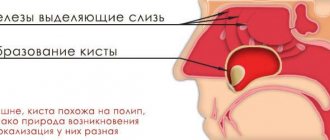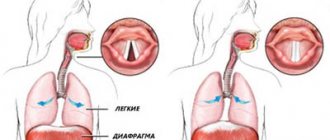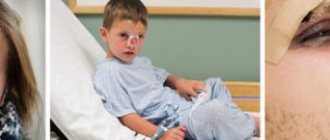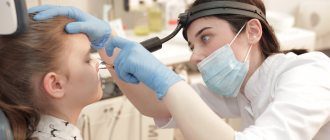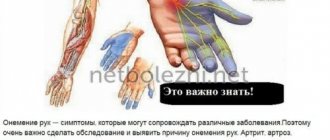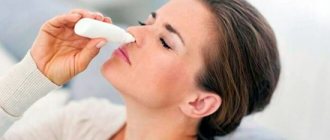According to statistics, vasoconstrictor nasal sprays and drops are the most popular means for treating a runny nose. These medications are available and can be purchased at any pharmacy without a doctor's prescription. Most patients consider rhinitis to be a banal ailment and limit themselves to the recommendations of pharmacists who select nasal drops without taking into account the diagnosis, severity and form of the disease, and the presence of complications.
Often the patient violates the recommended dosage regimen and duration of treatment. As a result of such “active” therapy, drug dependence on intranasal drugs develops. It is very difficult for a person to refuse drops, despite the fact that they only temporarily relieve swelling of the nasopharynx and do not allow them to cope with rhinitis.
At CELT you can consult an otorhinolaryngologist.
- Initial consultation – 3,000
- Repeated consultation – 2,000
Make an appointment
Causes of drug-induced rhinitis
Infectious or allergic rhinitis is manifested by inflammatory reactions, one of the symptoms of which is swelling of the nose. The body tries to cope with this process, and blood circulation increases in the nasal passages. As a result, an increase in the size of blood vessels contributes to the development of nasal congestion. Nasal breathing becomes difficult, the sense of smell is lost, the person rushes to get rid of these unpleasant symptoms with the help of decongestants (vasoconstrictor drops - vasoconstrictors).
From vasoconstrictor drops, blood vessels narrow, swelling quickly subsides, breathing through the nose is restored, and the sense of smell is normalized. The therapeutic effect of decongestants lasts 4-12 hours, after this period the lumen of the blood vessels increases again, swelling and congestion of the nasal passages returns. The patient knows how to get rid of the unpleasant condition and again uses vasoconstrictor drops.
If nasal vasoconstrictor drops are used correctly, addiction does not occur. The recommended period of use of the drugs is 3-7 days. Dependence manifests itself if the patient neglects the instructions for use and violates the frequency and duration of therapy. This is due to the fact that tachyphylaxis develops when the body’s response to repeated use of medications decreases. A person uses the same nasal remedies, but the vessels react poorly to them. To achieve a therapeutic effect, decongestants must be instilled more often.
The main active components of the drugs are substances such as nasazoline, oxymetazoline, xylometazoline, phenylephrine. Violation of the frequency and duration of therapy leads to the fact that the own regulation of capillary tone suffers. Up to the complete destruction of reflex regulation. The capillaries get used to narrowing from nasal drops and wait for the arrival of active components from the outside.
The longer a person uses vasoconstrictor drops, the stronger the addiction and the less chance of restoring their own regulation. You can only get rid of addiction to nasal drops with the help of an ENT specialist.
Causes of atopic rhinitis
Allergic rhinitis occurs upon contact with an allergen. The role of the provoking factor is:
- food (most often fish, milk and eggs);
- medicines;
- plant pollen:
- in spring: pollen of trees, especially hazel, birch and alder;
- in summer: pollen of grasses and flowers (the families of Poaceae, Chenopodiaceae, Asteraceae);
- fall: pollen from weeds, including ragweed and wormwood.
- house dust;
- insect allergens (cockroaches) and mold spores;
- animals. There is still no clear confirmation of the existence of hypoallergenic pets. This is due to the fact that allergies are provoked not so much by wool, but by saliva, urine and other biological fluids. Wool acts only as a carrier of allergens.
As a rule, increased sensitivity develops in people with a genetic predisposition. The family history of such patients often includes urticaria, bronchial asthma, diffuse neurodermatitis or other atopic conditions, which were confirmed in one or more close relatives. The basis of the disease is an immediate-type sensitization reaction, due to which symptoms appear both within a few seconds and within half an hour after contact with a potential allergen.
Symptoms of drug-induced rhinitis
The main symptoms of addiction to nasal drops:
- Nasal congestion does not go away on its own, but only after using vasoconstrictor drugs.
- Severe dependence on nasal drops. Often a person does not leave home without a bottle of medicine. The constant need for vasoconstrictors is similar to addiction to drugs.
- The nasal passages are constantly blocked, and it is difficult for a person to breathe, even if sinusitis, sinusitis or other underlying disease is completely treated.
- Burning, itching, and dry mucous membranes appear in the nasal sinuses.
- Colorless mucous discharge is constantly released.
- The sense of smell is partially or completely lost.
Indirect symptoms of dependence on vasoconstrictors:
- Systematic violation of the dosage regimen and non-compliance with the duration of medication. The patient reduces the intervals between instillation of drops and uses the drugs for more than 7 days.
- There is a feeling of panic when a person feels nasal congestion, but does not have decongestants on hand to relieve his condition.
A patient who has discovered such symptoms should come to an appointment with an ENT doctor!
How is allergic rhinitis different from a runny nose?
Allergy symptoms are similar to those of a cold. Common symptoms include runny nose, cough, and sore throat. Only an otolaryngologist can tell you how to distinguish an allergic runny nose from a cold.
Differences
| Possible manifestations | Allergic reaction | acute respiratory infections |
| Seasonality | Depends on the pathogen. Pollen has a clear seasonality. Household can be used year-round. | Mainly in autumn-winter and spring. |
| Signs of intoxication | Rarely | Almost always |
| Increased body temperature | Absent, occasionally rises to 37. | Almost always |
| Damage to systems other than the respiratory | Often | Rarely |
| Regular relapses of symptoms | Yes | No |
| Heredity | Genetic predisposition | No |
| Similarity of main symptoms | Almost always | Rarely |
| Blood analysis | There is an increase in the concentration of eosinophils | Signs of infectious etiology, including leukocytosis and increased ESR rate |
| Prick tests | Indicative | No signs of allergies |
| Indicators of the level of general IgE and specific IgE | Typical | No |
What are the dangers of abusing decongestants?
Uncontrolled use of vasoconstrictor drops leads to the fact that the capillaries are constantly in spasm. They stop functioning normally, blood flow is disrupted, and nearby tissues suffer because they do not receive the required amount of oxygen and nutritional components.
Systematic drying of the mucous membranes and disruption of its restoration threatens the development of malnutrition and the formation of drug-induced rhinitis. In an effort to get rid of seasonal runny nose as quickly as possible, a person acquires an illness that requires serious treatment.
The next danger is psychological addiction. A reflex is formed in the brain that normal breathing can only be restored with the help of medications. Using vasoconstrictor drops makes a person feel better; he does not think about the alarming consequences for his own health. Improper use of decongestant drops harms the entire body. Violation of the dosage regimen is especially dangerous in childhood. There are cases when a child has to be hospitalized because the mother intensively instilled drops into his nose. The danger is that vasoconstrictor drugs enter the general bloodstream and negatively affect all tissues and organs. Arterial hypertension may develop, shortness of breath, headache, insomnia, etc. may appear.
Most often, dependence on nasal drops is formed due to illiteracy of the population. Not everyone knows that harmless medications can cause intoxication of the entire body. If dangerous symptoms are detected, it is important to immediately seek medical help and receive timely treatment.
Symptomatic picture
Characteristic symptoms of allergic rhinitis in adults:
- feeling of nasal congestion and thick mucous discharge;
- rhinorrhea, which is manifested by copious watery discharge;
- itching in the eyes, nose, ears;
- inflammation of the pharyngeal mucosa;
- "sore throat;
- redness of the eyes;
- deterioration of taste and smell;
- bouts of sneezing;
- sometimes the body temperature is subfebrile and rises to 37;
- swelling of the eyelids and face;
- symptoms persist for more than 2 weeks.
In this case, rhinorrhea is more typical for seasonal rhinitis, and thick discharge with nasal congestion is more typical for year-round rhinitis. In 75% of patients, symptoms increase at night and early in the morning, as well as after direct contact with the allergen.
Important! If you notice such symptoms, you should consult a doctor. Self-medication is unacceptable!
Complications arising from drug-induced rhinitis
The most common adverse effects of rhinitis medicamentosa are:
- persistent swelling of the nasal passages;
- night snoring;
- lack of smell;
- nasal voice;
- headache;
- frequent sneezing and watery eyes;
- feeling of itching, tingling and burning in the nose;
- tissue atrophy;
- dryness and hyperplasia of the mucous membranes;
- nosebleeds;
- displacement of the nasal septum.
In most cases, doctors manage to rid the patient of drug addiction using conservative methods. Surgery is used when treatment is ineffective.
Diagnostics
For pain in the nose, a visit to an otolaryngologist is indicated. The doctor receives information valuable for making a diagnosis when collecting complaints, visual examination and palpation of the paranasal area, assessing the amount and nature of discharge. A diagnostic search in otolaryngology requires instrumental or laboratory research methods, the most informative of which are:
- Rhinoscopy.
When examining the nasal passages, pay attention to the color and presence of swelling of the mucous membrane, atypical growths or foreign bodies, and deformation of the nasal septum. To clarify the diagnosis, a nasal endoscopy is performed using modern equipment. - Radiography.
An X-ray of the nasal bones and paranasal sinuses is the standard method for identifying sinusitis, which is visualized as darkening and narrowing of the affected sinus. In case of traumatic injury, an X-ray or computed tomography of the facial skeleton is additionally performed. - Bacteriological research
. If there are signs of inflammation, the release of cloudy mucus or pus when sneezing, a smear test for microflora is required. When a boil is detected, a smear is taken from the top of the pustule to diagnose the type of bacterial flora and determine its sensitivity to antimicrobial agents. - Lab tests
. A clinical blood test shows nonspecific signs of inflammation (leukocytosis with a shift to the left, increased ESR); with massive nosebleeds, a decrease in hemoglobin and red blood cells is possible. Blood biochemistry is done in case of severe intoxication, for example, with an extensive burn complicated by a purulent process.
If the doctor suspects malignant transformation of cells, an endoscopic biopsy of the formation is performed, followed by histological examination. In case of multiple injuries to the bones of the skull and nose, the patient requires examination by a neurologist or neurosurgeon. If the pathological process affects the organ of vision, an ophthalmologist is involved in the diagnostic search.
For nasal pain, consultation with an otolaryngologist is indicated.
Treatment of addiction to nasal drops
The first stage is awareness of the problem. It is necessary to accept that an addiction to nasal drops or sprays has formed. Addiction worsens the quality of life and threatens serious complications.
The next step is to seek help from a competent ENT doctor. A specialist will help distinguish medicinal rhinitis from seasonal or allergic rhinitis, decide how serious the complications are, and select adequate treatment to restore nasal breathing. The sooner the patient contacts the doctor, the more successfully vascular function will be restored.
Drug addiction sometimes takes years to form, so you can’t get rid of it in a couple of days. Nasal breathing improves gradually. Medicines, physiotherapy methods and surgical interventions are used. To make you feel better, the doctor prescribes intranasal anti-inflammatory drugs containing synthetic glucocorticosteroids. The drugs improve the condition of the mucous membrane, facilitate the discharge of mucus, and relieve the symptoms of inflammation. The therapy is complemented by physiotherapeutic procedures - laser treatment, medicinal extracts (herbal medicine), the use of ultraviolet irradiation, tube quartz treatment, etc.
Preventive actions
The only preventative measure that will be truly effective is the complete exclusion of contact with the allergen. If the symptoms of allergic rhinitis are provoked by the epidermal cells of the animal, the animal should be removed from the house.
If the allergy is pollen, then a change of residence or installation of air filters in the house may be recommended. It is advisable to ensure low air humidity in the room and cover pillows and mattresses with special plastic covers.
With proper treatment of allergic rhinitis, its manifestations practically do not bother the patient. However, when the first symptoms appear, you should consult your doctor. Timely consultation will help avoid possible complications.
Surgical methods of treatment:
- Laser bloodless operation (vaporization), in which altered mucous membranes are removed by evaporation.
- Radio wave thermal reduction.
- An ultrasonic waveguide makes it possible to reduce the volume of blood vessels, after which healthy capillaries are formed in their place and nasal breathing is restored.
- Submucosal vasotomy, conchotomy.
Long-term use of vasoconstrictor drugs leads to serious consequences. Addiction will not go away on its own; specialist help is needed. You can get the necessary treatment at the CELT clinic. Here are high-quality diagnostics and effective therapy. Make an appointment with an ENT doctor right now.
Diseases leading to sinus pain
So what diseases can cause pain in the sinuses? This is a fairly voluminous list, so we will conditionally divide them into etiological reasons.
Inflammatory conditions, the main part of the pathologies that provoke this symptom:
- Sinusitis. Acute and chronic inflammatory processes in the paranasal sinuses - sinusitis, frontal sinusitis, ethmoiditis, sphenoiditis.
- Rhinitis. The catarrhal form can lead to chronic inflammation of the nasal mucosa, which provokes blockage in the paranasal sinuses. The so-called rhinosinusitis.
- Dental pathologies. If there are problems with the teeth of the upper jaw, emerging foci of inflammation can provoke the formation of a perforation or fistula in the maxillary sinus.
- Other states. Any focus of inflammation in the nasopharyngeal area can be complicated by spread to surrounding structures, for example, with chronic tonsillitis.
Diseases of non-inflammatory etiology can also lead to pain in the sinuses:
- A deviated nasal septum is the most common non-inflammatory cause of pain in the paranasal sinuses. More details in this material: Deviated nasal septum - symptoms, causes, complications.
- Trophic forms of rhinitis. Chronic changes in the mucous membrane during rhinitis can be not only inflammatory in nature, but also hypertrophic. For example: medicinal, atrophic, vasomotor and hypertrophic rhinitis. All of them contribute to the “blockage” of the outflow of secretions from the paranasal sinuses.
- Neoplasms. The growth of cysts and polyps can lead to the destruction of bone and cartilage tissue in the nasopharyngeal area, leading to corresponding symptoms.
- Other diseases. Hypertrophy of the adenoids or adenoid vegetations provoke a disruption of the normal patency of the nasal passages, thereby affecting the paranasal sinuses.
Our services
The administration of CELT JSC regularly updates the price list posted on the clinic’s website. However, in order to avoid possible misunderstandings, we ask you to clarify the cost of services by phone: +7
| Service name | Price in rubles |
| Appointment with a surgical doctor (primary, for complex programs) | 3 000 |
| Endoscopic rhinoscopy | 1 500 |
| X-ray of the paranasal sinuses | 2 200 |
All services
Make an appointment through the application or by calling +7 +7 We work every day:
- Monday—Friday: 8.00—20.00
- Saturday: 8.00–18.00
- Sunday is a day off
The nearest metro and MCC stations to the clinic:
- Highway of Enthusiasts or Perovo
- Partisan
- Enthusiast Highway
Driving directions
Sinuses hurt – how to treat?
The primary and most important recommendation is to visit a doctor.
You should not self-medicate, especially with chronic pain. In this situation, you simply cannot do without advanced diagnostics. The most comprehensive examination of the sinuses and paranasal area is carried out using nasal endoscopy and computed tomography. Therapeutic treatment , for example for sinusitis, consists of prescribing vasoconstrictor, mucolytic and antimicrobial drugs. The main goal is to suppress the inflammatory process and normalize the outflow of contents from the sinuses. Additionally, outside the stages of exacerbation, physiotherapeutic procedures, for example, UHF sinuses, can be prescribed. Salt rinses and inhalations also have a fairly good effect. For temporary pain relief, the use of painkillers, for example, NSAIDs (Nise, etc.) is allowed.
Of course, surgical treatment , especially for anatomical changes and chronic inflammatory conditions. Which depends on the root cause of sinus pain:
- For chronic sinusitis, various sinusotomies: maxillary sinusotomy, polysinusotomy, etc.
- For a deviated nasal septum – septoplasty.
- For adenoid hypertrophy - adenotomy.
Your counterpart specializes in endoscopic paranasal surgery. This is a more gentle effect, which allows you to minimize the time of both cure and recovery period. Discharge from the hospital usually occurs within 24 hours after surgery.
More detailed information about the surgical treatment of ENT organs is located on the corresponding page: Treatment of ENT diseases
How to get rid of unpleasant symptoms
Both before diagnosis and during treatment, you can rinse your nose with preparations based on sea water or use drops with silver ions to cleanse the mucous membrane and relieve the feeling of itching or burning of the mucous membrane.
An important point in the treatment of respiratory diseases is maintaining the required level of humidity and cleanliness of indoor air. The house must be regularly wet cleaned and dust must not accumulate. It is important that during the heating season the air humidity in the house or apartment is 40-60%.
Hardening, maintaining immunity, rules of personal hygiene, taking care of a balanced diet, combating physical inactivity and the absence of bad habits will create strong protection against damage to the nasal mucosa.
It is necessary to be attentive to the treatment of diseases of the upper respiratory tract and take care of respiratory protection when working with hazardous substances.
